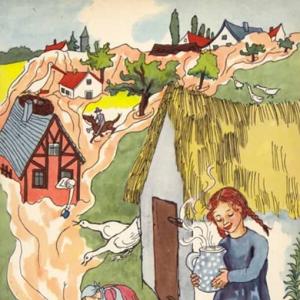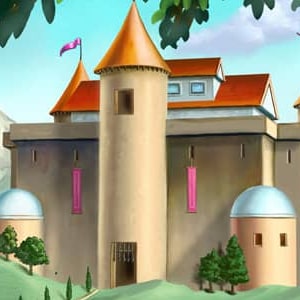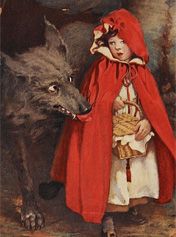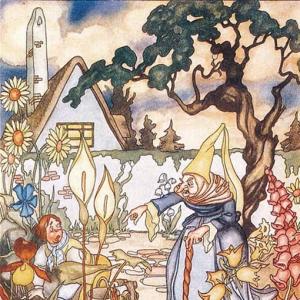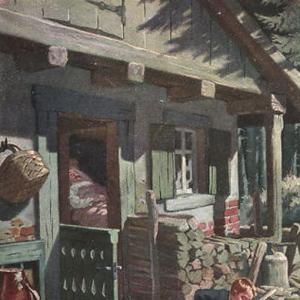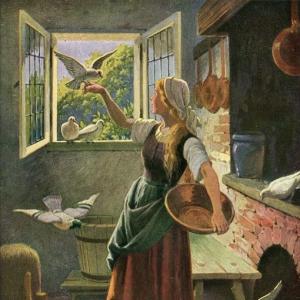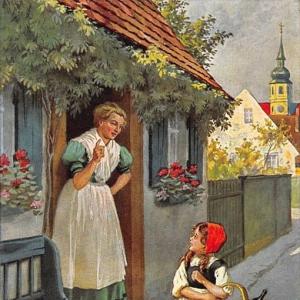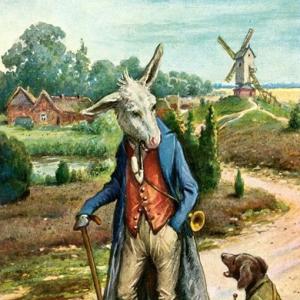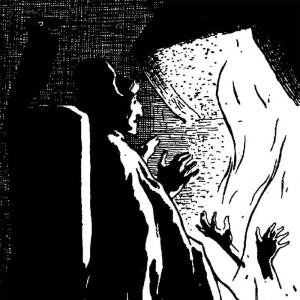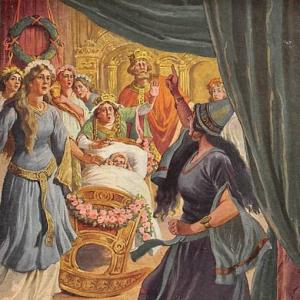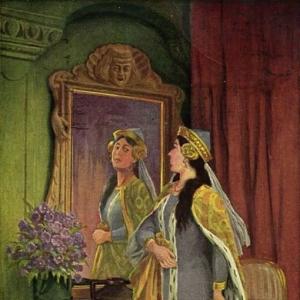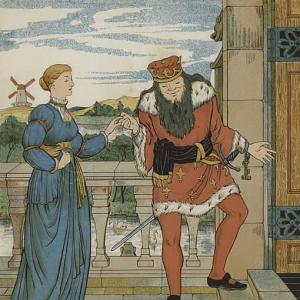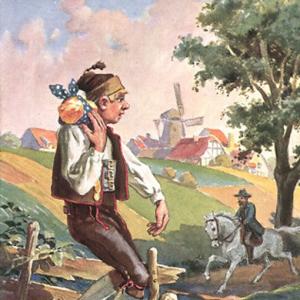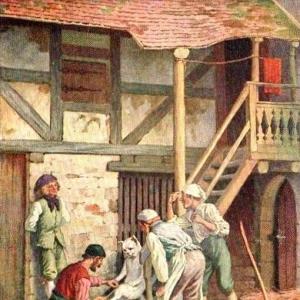Reading time for children: 9 min
Seven Swabians were once together. The first was Master Schulz. The second, Jackli. The third, Marli. The fourth, Jergli. The fifth, Michal. The sixth, Hans. The seventh, Veitli: all seven had made up their minds to travel about the world to seek adventures, and perform great deeds. But in order that they might go in security and with arms in their hands, they thought it would be advisable that they should have one solitary, but very strong, and very long spear made for them.
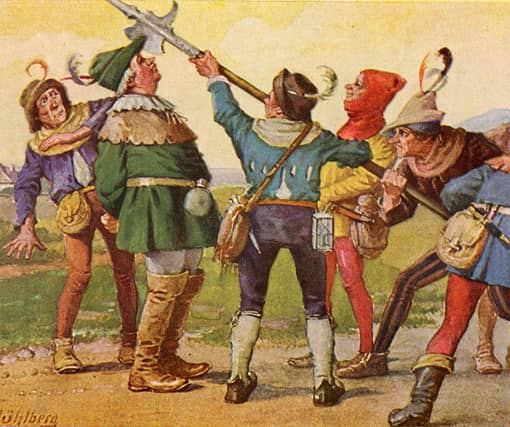 Image: Georg Mühlberg (1863-1925)
Image: Georg Mühlberg (1863-1925)This spear all seven of them took in their hands at once. In front walked the boldest and bravest, and that was Master Schulz; all the others followed in a row, and Veitli was the last. Then it came to pass one day in the hay-making month (July), when they had walked a long distance, and still had a long way to go before they reached the village where they were to pass the night, that as they were in a meadow in the twilight a great beetle or hornet flew by them from behind a bush, and hummed in a menacing manner. Master Schulz was so terrified that he all but dropped the spear, and a cold perspiration broke out over his whole body.
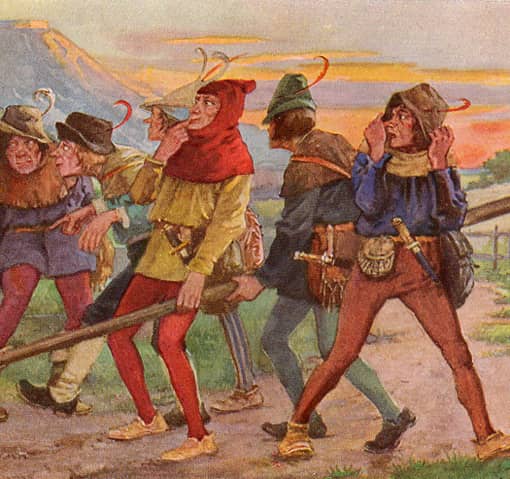 Image: Georg Mühlberg (1863-1925)
Image: Georg Mühlberg (1863-1925)„Hark! hark!“ cried he to his comrades, „Good heavens! I hear a drum.“ Jackli, who was behind him holding the spear, and who perceived some kind of a smell, said, „Something is most certainly going on, for I taste powder and matches.“
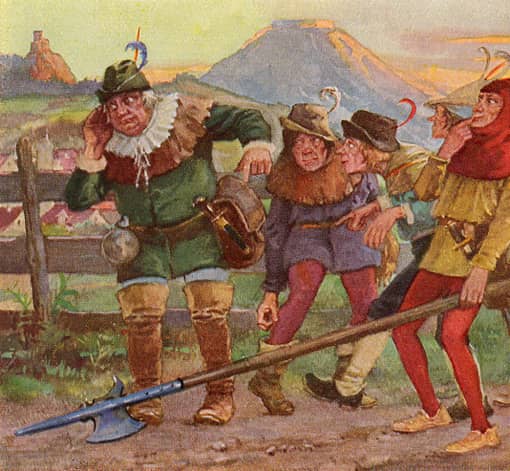 Image: Georg Mühlberg (1863-1925)
Image: Georg Mühlberg (1863-1925)At these words Master Schulz began to take to flight, and in a trice jumped over a hedge, but as he just happened to jump on to the teeth of a rake which had been left lying there after the hay-making, the handle of it struck against his face and gave him a tremendous blow. „Oh dear! Oh dear!“ screamed Master Schulz. „Take me prisoner. I surrender! I surrender!“
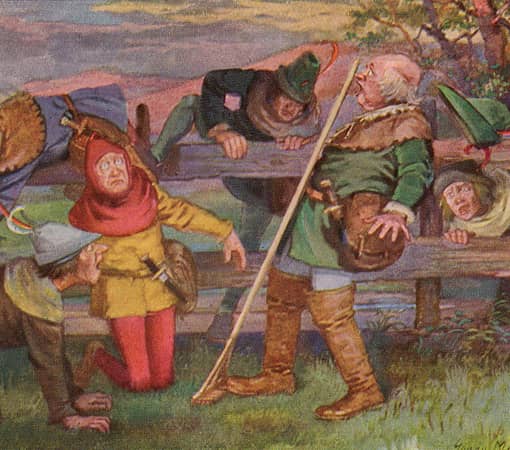 Image: Georg Mühlberg (1863-1925)
Image: Georg Mühlberg (1863-1925)The other six all leapt over, one on the top of the other, crying, „If you surrender, I surrender too! If you surrender, I surrender too!“ At length, as no enemy was there to bind and take them away, they saw that they had been mistaken, and in order that the story might not be known, and they be treated as fools and ridiculed, they all swore to each other to hold their peace about it until one of them accidentally spoke of it. Then they journeyed onwards. The second danger which they survived cannot be compared with the first. Some days afterwards, their path led them through a fallow-field where a hare was sitting sleeping in the sun. Her ears were standing straight up, and her great glassy eyes were wide open. All of them were alarmed at the sight of the horrible wild beast, and they consulted together as to what it would be the least dangerous to do.
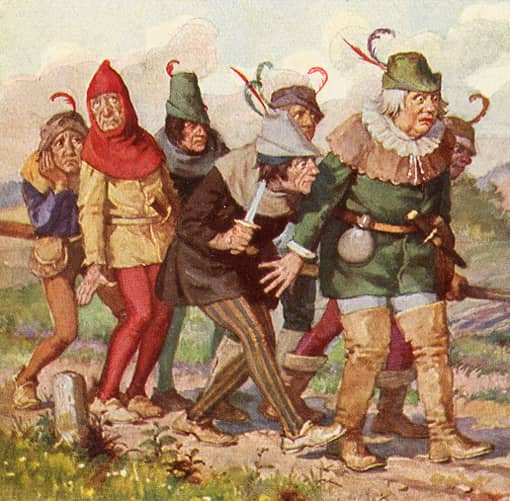 Image: Georg Mühlberg (1863-1925)
Image: Georg Mühlberg (1863-1925)For if they were to run away, they knew that the monster would pursue and swallow them whole. So they said, „We must go through a great and dangerous struggle. Boldly ventured, is half won,“ and all seven grasped the spear, Master Schulz in front, and Veitli behind. Master Schulz was always trying to keep the spear back, but Veitli had become quite brave while behind, and wanted to dash forward and cried,
„Strike home, in every Swabian’s name,
Or else I wish ye may be lame.“
But Hans knew how to meet this, and said,
„Thunder and lightning, it’s fine to prate,
But for dragon-hunting thou’rt aye too late.“
Michal cried,
„Nothing is wanting, not even a hair,
Be sure the Devil himself is there.“
Then it was Jergli’s turn to speak,
„If it be not, it’s at least his mother,
Or else it’s the Devil’s own step-brother.“
And now Marli had a bright thought, and said to Veitli,
„Advance, Veitli, advance, advance,
And I behind will hold the lance.“
Veitli, however, did not attend to that, and Jackli said,
„Tis Schulz’s place the first to be,
No one deserves that honor but he.“
Then Master Schulz plucked up his courage, and said, gravely,
„Then let us boldly advance to the fight,
And thus we shall show our valour and might.“
Hereupon they all together set on the dragon. Master Schulz crossed himself and prayed for God’s assistance, but as all this was of no avail, and he was getting nearer and nearer to the enemy, he screamed „Oho! oho! ho! ho! ho!“ in the greatest anguish. This awakened the hare, which in great alarm darted swiftly away. When Master Schulz saw her thus flying from the field of battle, he cried in his joy.
„Quick, Veitli, quick, look there, look there,
The monster’s nothing but a hare!“
But the Swabian allies went in search of further adventures, and came to the Moselle, a mossy, quiet, deep river, over which there are few bridges, and which in many places people have to cross in boats. As the seven Swabians did not know this, they called to a man who was working on the opposite side of the river, to know how people contrived to get across. The distance and their way of speaking made the man unable to understand what they wanted, and he said „What?
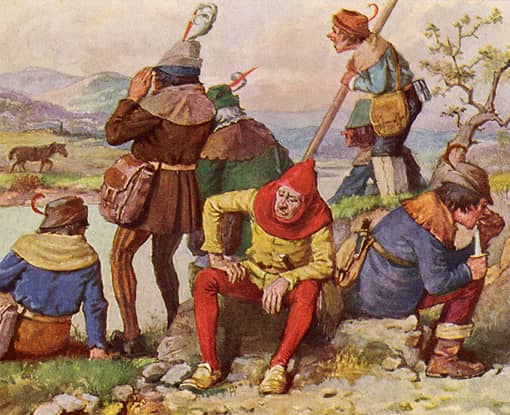 Image: Georg Mühlberg (1863-1925)
Image: Georg Mühlberg (1863-1925)what?“ in the way people speak in the neighborhood of Treves. Master Schulz thought he was saying, „Wade, wade through the water,“ and as he was the first, began to set out and went into the moselle. It was not long before he sank in the mud and the deep waves which drove against him, but his hat was blown on the opposite shore by the wind, and a frog sat down beside it, and croaked „Wat, wat, wat.“
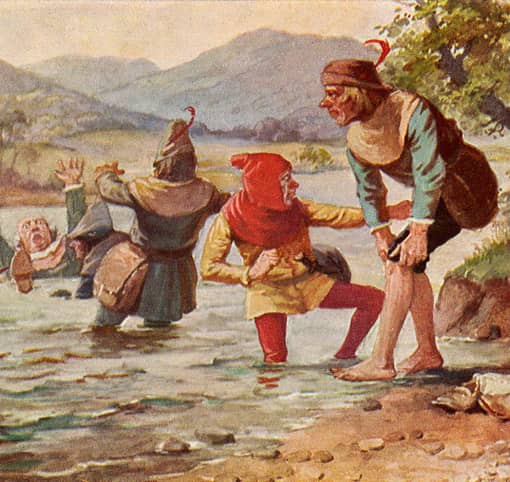 Image: Georg Mühlberg (1863-1925)
Image: Georg Mühlberg (1863-1925)The other six on the opposite side heard that, and said, „Oho, comrades, Master Schulz is calling us. If he can wade across, why cannot we?“ So they all jumped into the water together in a great hurry, and were drowned, and thus one frog took the lives of all six of them, and not one of the Swabian allies ever reached home again.
 Learn languages. Double-tap on a word.Learn languages in context with Childstories.org and Deepl.com.
Learn languages. Double-tap on a word.Learn languages in context with Childstories.org and Deepl.com.Backgrounds to fairy tale „The Seven Swabians“
„The Seven Swabians“ is a humorous and satirical fairy tale from the Brothers Grimm, included in their renowned collection „Grimm’s Fairy Tales.“ As with other Grimm’s tales, the story has its roots in the rich oral storytelling tradition of Germany. The tale is unique due to its satirical nature, which pokes fun at the stereotypes and perceived character traits of Swabians, a group of people from a region in southwest Germany called Swabia.
The story follows the adventures of seven Swabians, each named after a day of the week, who set out to seek their fortune and perform heroic deeds. They arm themselves with a single long spear, which they all carry together, and embark on their journey. The Seven Swabians face various challenges and encounters along the way, often resulting in comical and absurd situations.
One of the central themes of „The Seven Swabians“ is the importance of courage and common sense. The Swabians‘ misguided bravery and lack of practicality often lead them to make foolish decisions and find themselves in ridiculous predicaments. The tale serves as a satirical commentary on the regional stereotypes and cultural quirks of Swabians, poking fun at their perceived slowness, simplicity, and excessive thriftiness.
As with other Grimm’s fairy tales, „The Seven Swabians“ can be traced back to the oral storytelling tradition of Germany. These stories were passed down through generations, with each storyteller adding their own unique spin to the narrative. In the early 19th century, the Brothers Grimm began collecting and documenting these stories as part of their efforts to preserve German cultural heritage. Their anthology of fairy tales has since become an essential part of the Western literary canon, influencing countless writers and artists.
In summary, „The Seven Swabians“ is a satirical tale that humorously explores regional stereotypes, courage, and common sense. The story is rooted in the oral storytelling traditions of Germany and remains an enduring part of the broader cultural landscape of fairy tales, thanks to its inclusion in the Brothers Grimm’s collection.
Interpretations to fairy tale „The Seven Swabians“
„The Seven Swabians“ is a humorous and satirical fairy tale from the Brothers Grimm, which offers several interpretations and themes. Some possible interpretations of the story include:
Satire and Stereotypes: The story pokes fun at the regional stereotypes and cultural quirks of Swabians, a group of people from a region in southwest Germany called Swabia. It humorously highlights their perceived slowness, simplicity, and excessive thriftiness. The tale serves as a reminder of the dangers of relying on stereotypes and the importance of understanding individual differences.
The Importance of Common Sense and Practicality: The Seven Swabians often find themselves in absurd and comical situations due to their lack of common sense and practicality. This theme emphasizes the importance of using one’s judgment and applying practical solutions to problems rather than relying solely on bravery or boldness.
Misguided Bravery and False Heroism: The Seven Swabians set out to seek their fortune and perform heroic deeds, but their misguided bravery leads them into various predicaments. This theme serves as a reminder that true heroism requires wisdom and understanding, not just courage.
Unity and Teamwork: Despite their various shortcomings, the Seven Swabians are united and work together throughout their adventures. This theme can be interpreted as a message about the importance of unity and teamwork in overcoming obstacles and achieving success.
The Role of Humor in Storytelling: „The Seven Swabians“ is a humorous and satirical tale, which provides an entertaining and engaging way to explore themes and convey moral lessons. The use of humor in the story highlights the value of laughter and amusement in storytelling and the human experience.
In summary, „The Seven Swabians“ offers multiple interpretations, allowing readers to explore themes such as satire, stereotypes, common sense, practicality, bravery, unity, and the role of humor in storytelling. The story also offers insights into the cultural and historical context of the time when it was collected and recorded by the Brothers Grimm.
Adaptions of the fairy tale „The Seven Swabians“
„The Seven Swabians“ is not as well-known as some other Grimm’s fairy tales, and as a result, it has not received as many adaptations as their more popular stories. However, there have been a few adaptations and references to the tale in different media. Some examples include:
„Die sieben Schwaben“ (Animated Film, 1949): An animated film adaptation of „The Seven Swabians“ was produced in 1949 by the DEFA animation studio in East Germany. The film, titled „Die sieben Schwaben,“ offers a vivid animated retelling of the story, making the humorous and satirical tale accessible to audiences of different cultures and ages.
„Die Sieben Schwaben“ (Radio Play): A German radio play titled „Die Sieben Schwaben“ is an adaptation of „The Seven Swabians.“ Radio plays offer a unique way for audiences to experience the story, as they rely on voice acting, music, and sound effects to bring the tale to life.
Picture Books and Retellings: While not as popular as other Grimm’s fairy tales, „The Seven Swabians“ has been adapted into a few picture books and retellings. These versions usually feature illustrations and simplified language, making the story more accessible to younger readers.
Theater and Puppet Shows: „The Seven Swabians“ has been adapted for the stage in various forms, including theater performances and puppet shows. These live adaptations provide an engaging and entertaining way for audiences to experience the story and its humorous themes.
While „The Seven Swabians“ may not have as many adaptations or be as well-known as some other Grimm’s fairy tales, these examples demonstrate that the story still inspires storytellers and offers entertainment to audiences in various forms.
Adaptions of the fairy tale „The Seven Swabians“
„The Seven Swabians“ has been adapted and retold in various forms over the years, including:
Children’s books: The tale has been adapted into numerous children’s books, such as „The Seven Swabians“ by Jacob and Wilhelm Grimm, illustrated by Bernadette Watts.
Theater: The story has been adapted for the stage, with various theatrical productions and adaptations performed in different parts of the world.
Films: The tale has been adapted into several films, including the 1937 German film „Die sieben Schwaben“ directed by Erich Engel.
Television: The story has been adapted for television in various formats, such as animated series and live-action productions.
Comics: The tale has also been adapted into comic books and graphic novels, including „The Seven Swabians“ by J. Otto Seibold.
Video games: The story has been adapted into a video game called „The Seven Swabians“ by German game developer Daedalic Entertainment.
Each adaptation of the tale presents a unique interpretation and creative retelling of the original story, highlighting different themes and emphasizing different aspects of the characters and plot.
Summary of the plot
„The Seven Swabians“ is a humorous and satirical fairy tale from the Brothers Grimm that follows the adventures of seven Swabians, each named after a day of the week, who set out to seek their fortune and perform heroic deeds. The tale is unique due to its focus on the Swabians, a group of people from the region of Swabia in southwest Germany, and the story pokes fun at the stereotypes and perceived character traits of these people.
Armed with a single long spear, which they all carry together, the Seven Swabians embark on their journey. Throughout their adventures, they face various challenges and encounters, often leading to comical and absurd situations due to their lack of common sense and practicality. They confront a supposed dragon, which turns out to be a snail, and later face a hare, which they mistake for a terrifying beast. In each case, their misguided bravery and lack of wisdom result in humorous predicaments.
The story concludes with the Seven Swabians attempting to cross a river by wading through it one by one, each holding onto the spear. As the first Swabian reaches the middle of the river, he is attacked by a crayfish and lets out a scream, causing the others to panic and drown. The final Swabian, believing that his companions have been swallowed by a sea monster, returns home and recounts their tragic adventures.
In summary, „The Seven Swabians“ is a satirical and entertaining tale that humorously explores regional stereotypes, courage, and common sense. The story serves as a reminder of the importance of using wisdom and practicality in facing challenges and the dangers of relying on stereotypes when judging others.
———————-
Backgrounds to fairy tale „The Seven Swabians“
„The Seven Swabians“ is a German fairy tale collected by the Brothers Grimm, Jacob and Wilhelm, in their famous collection „Grimms‘ Fairy Tales“ (originally titled „Children’s and Household Tales“ or „Kinder- und Hausmärchen“ in German). The Brothers Grimm were German academics, philologists, and cultural researchers who compiled and published over 200 folktales in the early 19th century.
The Swabians in the title refer to a group of people from Swabia, a historical region in present-day southwest Germany that includes parts of the modern states of Baden-Württemberg and Bavaria. Swabian culture, language, and customs have distinct features, and the term „Swabian“ often carries a stereotype of a simple, frugal, and unsophisticated person.
The fairy tale, like many of the stories collected by the Brothers Grimm, has roots in oral tradition and folklore. It was first published in 1815 in the second volume of their collection. The story serves as a humorous and cautionary tale, using the adventures of the seven Swabians to convey various messages and morals, as outlined in the interpretations above.
It is important to note that the Brothers Grimm did not create the stories in their collection; rather, they gathered them from various sources, including friends, acquaintances, and written texts. As the stories were passed down through generations, they evolved and changed, reflecting the values and beliefs of the time. The Brothers Grimm played a significant role in preserving these traditional stories for future generations and popularizing them worldwide.
Interpretations to fairy tale „The Seven Swabians“
„The Seven Swabians“ is a cautionary tale that can be interpreted in various ways. Some possible interpretations include:
Overconfidence and foolishness: The Swabians‘ misadventures demonstrate the dangers of overconfidence and foolishness. They repeatedly misinterpret their surroundings and jump to conclusions, leading them to make grave mistakes. The story serves as a reminder that it is essential to assess situations carefully and think critically before taking action.
The importance of communication: The Swabians‘ downfall at the Moselle River highlights the importance of clear communication. Misunderstanding the local man’s response, they make a fatal decision. The story emphasizes the need for effective communication to avoid misunderstandings and their potentially disastrous consequences.
The dangers of groupthink: Throughout the story, the Swabians follow each other’s actions without questioning their validity. This conformity leads to a series of poor decisions and ultimately their demise. The tale can be seen as a warning against blindly following the crowd and the importance of independent thinking.
Fear and its consequences: Fear is a recurring theme in the story, as the Swabians are easily frightened by harmless creatures and situations. Their fear leads them to overreact and make irrational decisions. The tale illustrates the power of fear and the importance of facing it with courage and rationality.
Satire on chivalry and heroism: The story can be read as a satirical take on the chivalric tales popular during the time. The Swabians, attempting to perform great deeds and seek adventures, end up bumbling their way through their journey. The tale mocks the romanticized notion of heroism by depicting the protagonists as naive and foolish.
Summary of the plot
„The Seven Swabians“ is a fairy tale by the Brothers Grimm that tells the story of seven Swabian men who set out on a journey to seek adventures and perform great deeds. The seven Swabians are Master Schulz, Jackli, Marli, Jergli, Michal, Hans, and Veitli. They decide to travel with a single long spear for protection, which all of them hold at once.
While walking through a meadow one day, they hear a beetle or hornet humming menacingly. Fearing it is a drum signaling an enemy attack, they flee, only to realize they were mistaken. To avoid ridicule, they vow to keep the incident a secret. Soon after, they encounter a sleeping hare in a field, which they mistake for a fearsome monster. They work up the courage to attack the „monster,“ but the hare simply wakes up and runs away.
The Swabians continue their journey and arrive at the Moselle River, where they see a man working on the opposite bank. They ask how to cross the river, but the man doesn’t understand them and replies with „What? What?“ Master Schulz, misunderstanding the response as „Wade, wade through the water,“ attempts to cross the river on foot, but drowns. The others hear a frog croaking nearby and, thinking it’s Master Schulz calling for them, also try to cross the river and subsequently drown. In the end, the seven Swabians perish, and none of them ever return home.
Informations for scientific analysis
Fairy tale statistics | Value |
|---|---|
| Number | KHM 119 |
| Translations | DE, EN, ES, FR, PT, HU, IT, JA, NL, PL, RU, TR, VI, ZH |
| Readability Index by Björnsson | 26.7 |
| Flesch-Reading-Ease Index | 82.7 |
| Flesch–Kincaid Grade-Level | 5.4 |
| Gunning Fog Index | 7.5 |
| Coleman–Liau Index | 8.6 |
| SMOG Index | 8 |
| Automated Readability Index | 5.5 |
| Character Count | 5.567 |
| Letter Count | 4.259 |
| Sentence Count | 70 |
| Word Count | 1.026 |
| Average Words per Sentence | 14,66 |
| Words with more than 6 letters | 124 |
| Percentage of long words | 12.1% |
| Number of Syllables | 1.325 |
| Average Syllables per Word | 1,29 |
| Words with three Syllables | 49 |
| Percentage Words with three Syllables | 4.8% |

